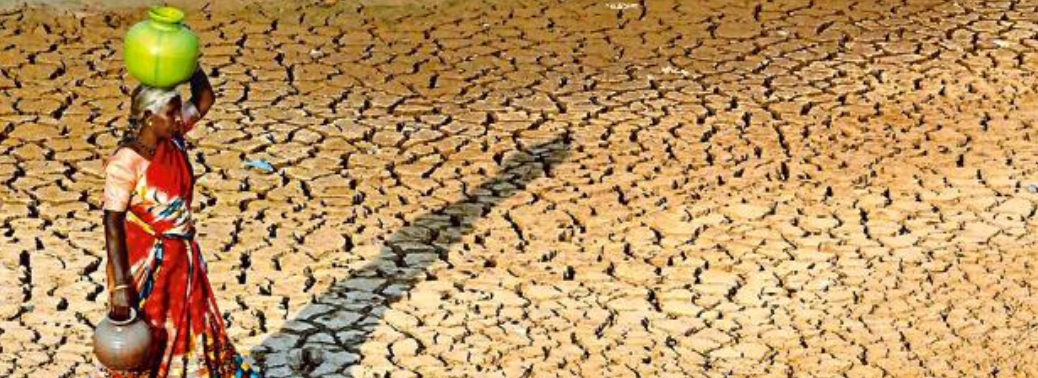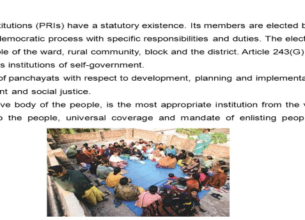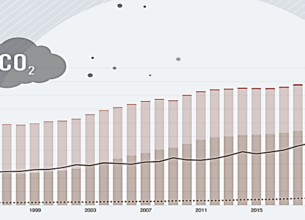DESERTIFICATION OF LAND AROUND THE WORLD
13, Sep 2019

Prelims level : Environment- Climate Change & Its Impact
Mains level : GS-III- Conservation, Environmental Pollution and Degradation, Environmental Impact Assessment.
Why in News?
- According to a report tabled at the ongoing 14the Conference of Parties to the United Nations Convention to Combat Desertification (UNCCD) every year around 12 million hectares fall to desertification. The cost to combat these has been estimated at $450 billion annually.
- At the end of talks on 13th September, the conference is expected to come out with a declaration on the decisions taken here to deal with desertification.
What is Desertification?
- According to UNCCD: Desertification is not the natural expansion of existing deserts but the degradation of land in arid, semi-arid, and dry sub-humid areas.
- It is a gradual process of soil productivity loss and the thinning out of the vegetative cover because of human activities and climatic variations such as prolonged droughts and floods.
- What is alarming is that though the land’s topsoil, if mistreated, can be blown and washed away in a few seasons, it takes centuries to build up.
- Among human causal factors are overcultivation, overgrazing, deforestation, and poor irrigation practices. Such overexploitation is generally caused by economic and social pressure, ignorance, war, and drought. Combating desertification refers to activities that prevent or reduce land degradation, and restore partially or fully degraded land.
Concerns:
- A variety of factors, both natural and human-induced, are known to be affecting the productivity of land, and making them desert-like.
- Increasing populations and the resultant rise in demand for food and water, feed for cattle, and a wide variety of ecosystem services these offer, have prompted human beings to clear forests, use chemicals, cultivate multiple crops, and over-exploit groundwater.
- This has affected both the health and productivity of land. Natural processes such as rising global temperatures increase the frequency and intensity of droughts, and changing weather patterns have put further pressure on the land.
- Desertification has implications for food and water security, livelihoods, migration, conflicts and even international security.
Magnitude of The Problem:
- A recent report by the International Resources Panel, a scientific body hosted by the UN Environment Programme, said that about 25 per cent of world’s land area has been degraded.
- Another report, by the Intergovernmental Science Policy Platform on Biodiversity and Ecosystem Services, said that nearly 40 per cent of world’s population was being impacted negatively because of land degradation.
- According to the Intergovernmental Panel on Climate Change (IPCC) the rate of soil erosion in many areas of the world was up to 100 times faster than the rate of soil formation.
- It also said the annual area of drylands in drought had been increasing at more than 1 per cent every year in the last 50 years, and that nearly 500 million people lived in areas that have experienced desertification after the 1980s.
UN Convention to Combat Desertification (UNCCD):
- The UNCCD is one of three Conventions that have come out of the historic 1992 Earth Summit in Rio de Janeiro.Established in 1994, the United Nations Convention to Combat Desertification (UNCCD) is the sole legally binding international agreement linking environment and development to sustainable land management.
- The Convention addresses specifically the arid, semi-arid and dry sub-humid areas, known as the drylands, where some of the most vulnerable ecosystems and peoples can be found.
- As the dynamics of land, climate and biodiversity are intimately connected, the UNCCD collaborates closely with the other two Rio Conventions; the Convention on Biological Diversity (CBD) and the United Nations Framework Convention on Climate Change (UNFCCC), to meet these complex challenges with an integrated approach and the best possible use of natural resources.
Need for Such a Convention:
- At the time the UNCCD was born in Rio, degradation of land was mostly viewed as a localised problem, one that was mainly affecting countries in Africa. In fact, it was on the demand of the African countries that CCD came into being. The Convention repeatedly makes a mention of the special needs of Africa in fighting desertification.
- Over the years, it has become increasingly clear that land degradation was impacting the global network of food and commodity supply chains and was getting impacted in return.
- The crops being grown and the quantities in which they were being grown were dictated not by local needs but by global demands. Changes in food habits and international trade have altered cropping patterns in many areas.
- Large-scale migration to urban centres and industrial hubs has seen a heavy concentration of populations in small areas, putting unsustainable pressure on land and water resources.
- As an issue, therefore, land degradation of land is, therefore, much more complex than it appears.
Climate Change & Land Degradation:
- Land has always been an important conversation in the climate change debate. That is because land affects, and is affected by, climate change.
- Forests, trees and vegetation cover are important sinks of carbon dioxide. Land degradation, therefore, reduces the amount of carbon dioxide that is absorbed, and consequently leads to a rise in emissions.
- At the same time, agriculture and activities such as cattle rearing contribute to emissions and are a major source of methane which is a much stronger greenhouse gas than carbon dioxide. Restoration of degraded land can, therefore, have major co-benefits for climate change objectives.
- According to the report by the International Resources Panel referred to earlier, restoring 350 million hectares of degraded landscape by 2030 would take out between 13 to 26 billion tonnes of greenhouse gas emissions from the atmosphere. This would more than offset the emissions from activities like agriculture and cattle-rearing.
- The IPCC report mentioned earlier had estimated that such activities contribute about 25 per cent of annual greenhouse gas emissions, or about 12 billion tonnes of carbon dioxide equivalent.








